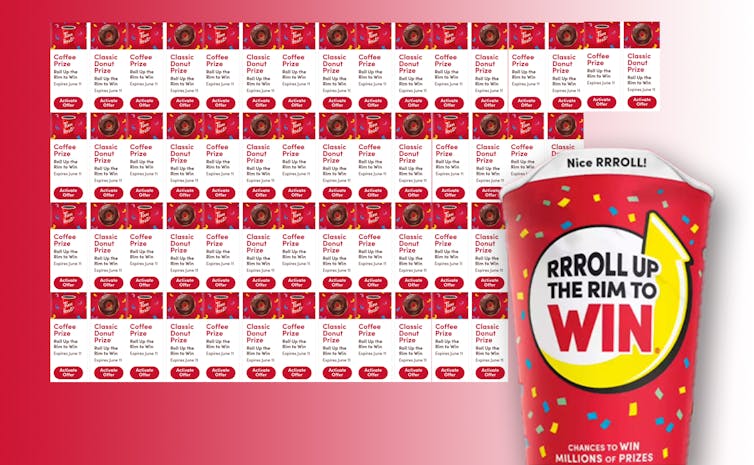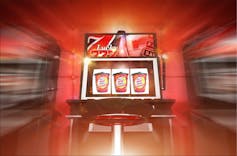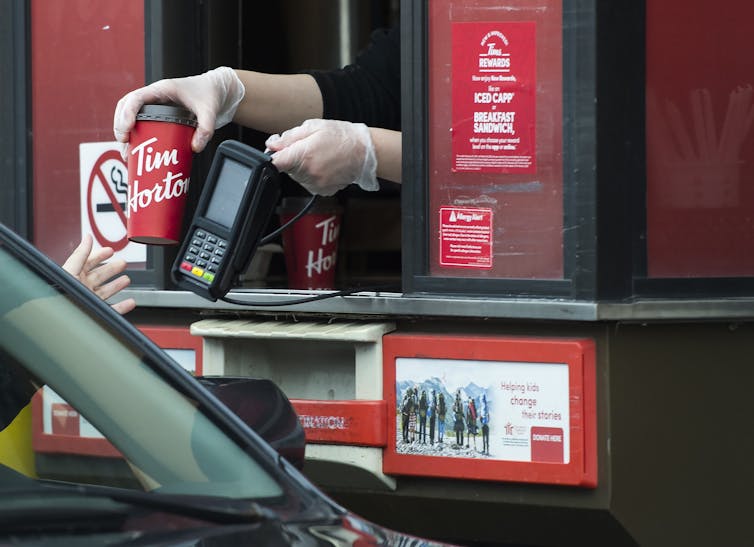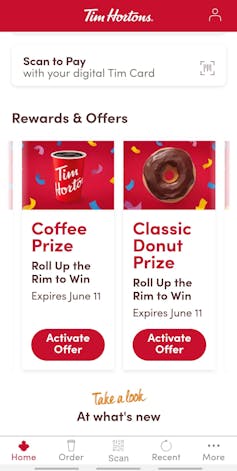 A
statistics
professor
used
his
expertise
in
calculating
probabilities
to
come
up
with
a
98
winning
percentage
for
Tim
Hortons
popular
Roll
up
the
Rim
contest.
(Photo
Illustration/The
Conversation),
CC
BY-NC
A
statistics
professor
used
his
expertise
in
calculating
probabilities
to
come
up
with
a
98
winning
percentage
for
Tim
Hortons
popular
Roll
up
the
Rim
contest.
(Photo
Illustration/The
Conversation),
CC
BY-NC
Michael Wallace, University of Waterloo
In 2003, geological statistician Mohan Srivastava cracked a Canadian lottery game. After getting a scratch-off ticket as a gift, he spotted a flaw in the game. Putting his probability skills to work, he figured out how to identify winning tickets prior to purchase. It didn’t make him rich — “beating the game wasn’t worth my time,” he said — but Srivastava’s experience showed it’s very hard to make a truly random game.
Tim Hortons launched its annual Roll up the Rim promotion in mid-March. Due to the coronavirus pandemic, the contest’s iconic physical cups were replaced by a digital game on the company’s loyalty app. This change had major implications for how prizes were awarded. It also created an opportunity to shift the odds heavily in your favour.
Under the old format, the mechanics of the game were simple. Tim Hortons would print millions of promotional cups and about one out of every six cups had a prize under its paper rim. If the company expected to sell 180 million coffees during the contest period, then they’d print 180 million promotional cups and make about 30 million of them winners. Stores would then sell the cups until supplies ran out.
This meant that while Tim Hortons couldn’t perfectly predict how many coffees they’d sell during the contest period, the odds remained the same. If sales were unexpectedly high, the cups would simply run out sooner. If sales were low, the game would last a little longer. Either way, the number of prizes and the number of cups given out — the numerator and denominator of our probability equation — were fixed.
‘Digital rolls’ changed the odds
This year, the digital game changed all that. Instead of physical cups, players earned “digital rolls” with their purchases. These could be rolled at any time by tapping a virtual coffee cup on the app.
Unlike the physical cups however, Tim Hortons couldn’t control how many digital rolls were given out. It depended on their actual sales during the four-week contest period. The number of prizes (the numerator) was still fixed, but the number of entries (the denominator) was out of their hands. They had to find a new way to distribute the prizes.
The
solution,
as
I
wrote
about
before
the
start
of
the
contest,
meant
Roll
up
the
Rim
became
a
bit
like
a
slot
machine.
 Changes
to
Roll
up
the
Rim
contest
made
the
game
more
like
a
slot
machine.
(Photo
Illustration/The
Conversation),
CC
BY-NC
Changes
to
Roll
up
the
Rim
contest
made
the
game
more
like
a
slot
machine.
(Photo
Illustration/The
Conversation),
CC
BY-NC
Each prize — from a coffee to a car — was assigned a “winning timeframe,” a short period of time during which it could be won. If you were the first player to tap your app during that timeframe, you won the prize. Tim Hortons could then distribute all the advertised prizes across the contest period and every single one — at least in theory — could be won.
With some of these winning timeframes as short as 0.1 seconds though, it was certainly possible some would pass with no one playing a roll. Anticipating this, Tim Hortons included a rule where any unclaimed prizes were rolled over to another day of the contest, right up until the final day. A prize would only go unclaimed if it wasn’t won by the digital roll deadline at midnight on April 21. Although the in-store contest ended April 7, players had an additional two weeks to use their digital rolls.
Prizes rolled over
This
new
game
format
meant
your
odds
of
winning
depended
not
only
on
how
many
digital
rolls
you
earned,
but
also
how
many
others
were
playing.
If
sales
were
low,
then
fewer
people
would
play
—
and
more
of
those
winning
timeframes
would
pass
without
the
prize
being
claimed.
Those
unclaimed
prizes
would
roll
over
—
and
keep
rolling
over
—
until
the
contest
deadline.
 It’s
not
known
whether
social
isolation
had
an
impact
on
the
number
of
people
who
played
Roll
up
the
Rim
this
year.
THE
CANADIAN
PRESS/Nathan
Denette
It’s
not
known
whether
social
isolation
had
an
impact
on
the
number
of
people
who
played
Roll
up
the
Rim
this
year.
THE
CANADIAN
PRESS/Nathan
Denette
We don’t know for sure because Tim Hortons hasn’t announced its sales figures during the contest, but it’s reasonable to assume that fewer coffees have been sold during the coronavirus pandemic lockdown. Lower sales could theoretically increase the odds of winning a prize through the app, but only if you knew when to play.
As a statistics professor, it seemed appropriate to conduct a small experiment. I knew there was little chance of winning a big prize — over 99 per cent of the contest’s prizes are coffee or doughnuts — but I was statistically curious.
There were other factors to consider. How randomly were the prizes distributed? Were they more likely to be won during the start of the contest? What times of day did people play? Was I more likely to win in the middle of the night? There was no way to know for sure, but I made some guesses and got to work.
An avalanche of unclaimed prizes
Taking advantage of the various ways to earn bonus rolls (such as owning a reusable cup or making a purchase through the app), I racked up 96 entries. I then waited until the very last day of the contest to play them. If my theory was correct, based on statistical models I had calculated before playing, there would be an avalanche of unclaimed prizes waiting to be won.
Waking up at 5 a.m. — I wanted to minimize the chance I was playing at the same time as someone else — I was finally ready to roll.
On
my
first
play,
I
won
a
free
coffee.
A
good
start,
but
maybe
I’d
just
gotten
lucky.
 Author
Michael
Wallace
won
67
coffees
and
27
donuts
within
a
few
minutes
by
calculating
the
best
time
to
play
Roll
up
the
Rim.
Author
provided
Author
Michael
Wallace
won
67
coffees
and
27
donuts
within
a
few
minutes
by
calculating
the
best
time
to
play
Roll
up
the
Rim.
Author
provided
I played again. Another coffee. Then a doughnut. Then another coffee. It took nearly 15 minutes to play my 96 rolls.
I lost twice.
I didn’t win a car or a TV or even a $25 Tim Hortons gift card, but I didn’t expect to. I won 67 coffees and 27 doughnuts — my statistical models predicted I’d win 66 and 28.
With 94 wins out of 96 entries, I had a 98 per cent success rate. Before the contest, Tim Hortons estimated a player’s chances were just 1-in-9, or about 11 per cent. By finding predictable elements in a seemingly random process, I was able to dramatically shift those odds. I’ll be telling my probability students about this for years.
Like Mohan Srivastava, I knew this wasn’t a get-rich-quick scheme. Your odds of landing a big prize — even when almost every roll is a winner — are still incredibly small.
The contest rules suggest the value of my prizes if I buy the most expensive coffees and doughnuts possible is about $500. Not a bad return on investment, but I’m going to see if Tim Hortons can donate the prizes to my local hospital instead.
Michael Wallace, Assistant Professor, Department of Statistics and Actuarial Science, University of Waterloo
This article is republished from The Conversation under a Creative Commons license. Read the original article.
The story was also picked up by Macleans, CTV Kitchener, and many Metroland Media Group outlets across Ontario. Wallace was also interviewed on the Lynda Steele show on CKNW 980 Vancouver.